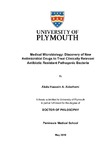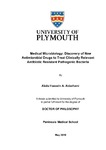Medical Microbiology: Discovery of New Antimicrobial Drugs to Treat Clinically Relevant Antibiotic Resistant Pathogenic Bacteria
| dc.contributor.supervisor | Upton, Mathew | |
| dc.contributor.author | Aldarhami, Abdu Hussein A. | |
| dc.contributor.other | Faculty of Health | en_US |
| dc.date.accessioned | 2019-09-11T15:14:39Z | |
| dc.date.issued | 2019 | |
| dc.identifier | 10514907 | en_US |
| dc.identifier.uri | http://hdl.handle.net/10026.1/14911 | |
| dc.description | Edited version embargoed until 09.09.2022 Full version: Access restricted permanently due to 3rd party copyright restrictions. Restriction set on 11.09.2019 by SE, Doctoral College | |
| dc.description.abstract |
Antimicrobial resistance (AMR) is one of the greatest world-wide threats to human health and urgent action is needed to reduce the potentially devastating social and economic impacts that may result from continued spread of drug resistant infections. These actions include discovery of new antibiotics and community engagement in AMR. Natural product screening methods are arguably the most efficient way to identify novel antibiotics, but can be frustrated by the repeated discovery of known compounds, wasting valuable resources, effort and time. Thus, exploiting obscure, hard to reach environments and implementing combined bioinformatic and proteomic screening approaches may short-cut the process of discovery of unique agents. In addition, educating and engaging the public will raise their awareness about AMR, which could reduce misuse of antibiotics. In this project, a total of 633 bacterial isolates were obtained from various clinical and environmental samples, including those provided by members of the general public. These isolates were screened for antimicrobial production using various antagonism assays. Draft genomes of 26 selected antagonistic strains were determined and mined in-silico using BAGEL-3 and antiSMASH-4.0 tools. Based on the findings, six isolates were further analysed using various proteomic strategies. The spectrum of activity, physicochemical properties and/or toxicity of purified compounds were investigated. This has led to the discovery of multiple novel compounds, including nisin-P, EU4-B synthetic peptide and EU4-natural product, which displayed diverse activity spectra towards pathogenic microorganisms. Aside from these results, the engagement of the general public, many of whom had limited prior awareness of AMR, is another important outcome. The optimized proteogenomic analysis has provided a means to shortcut some of the more laborious dereplication methods and has facilitated rapid identification of novel antimicrobial agents. In addition, this work has provided further evidence indicating that bacteria from the deep sea could be a rich source of novel compounds. Further investigation of all of the compounds discovered here may provide evidence justifying pre-clinical progression for future use against clinically relevant, drug resistant bacteria. | en_US |
| dc.description.sponsorship | Taif University, Saudi Arabia | en_US |
| dc.language.iso | en | |
| dc.publisher | University of Plymouth | |
| dc.rights | Attribution-NonCommercial-NoDerivs 3.0 United States | * |
| dc.rights.uri | http://creativecommons.org/licenses/by-nc-nd/3.0/us/ | * |
| dc.subject | Antibiotic Discovery | en_US |
| dc.subject | Natural Products Screening | en_US |
| dc.subject | Antimicrobial Peptides | en_US |
| dc.subject | Bacteriocins | en_US |
| dc.subject.classification | PhD | en_US |
| dc.title | Medical Microbiology: Discovery of New Antimicrobial Drugs to Treat Clinically Relevant Antibiotic Resistant Pathogenic Bacteria | en_US |
| dc.type | Thesis | |
| plymouth.version | non-publishable | en_US |
| dc.identifier.doi | http://dx.doi.org/10.24382/1077 | |
| dc.rights.embargoperiod | Extended | en_US |
| dc.type.qualification | Doctorate | en_US |
| rioxxterms.version | NA | |
| plymouth.orcid.id | https://orcid.org/0000-0002-0950-9263 | en_US |
Files in this item
This item appears in the following Collection(s)
-
01 Research Theses Main Collection
Research Theses Main




